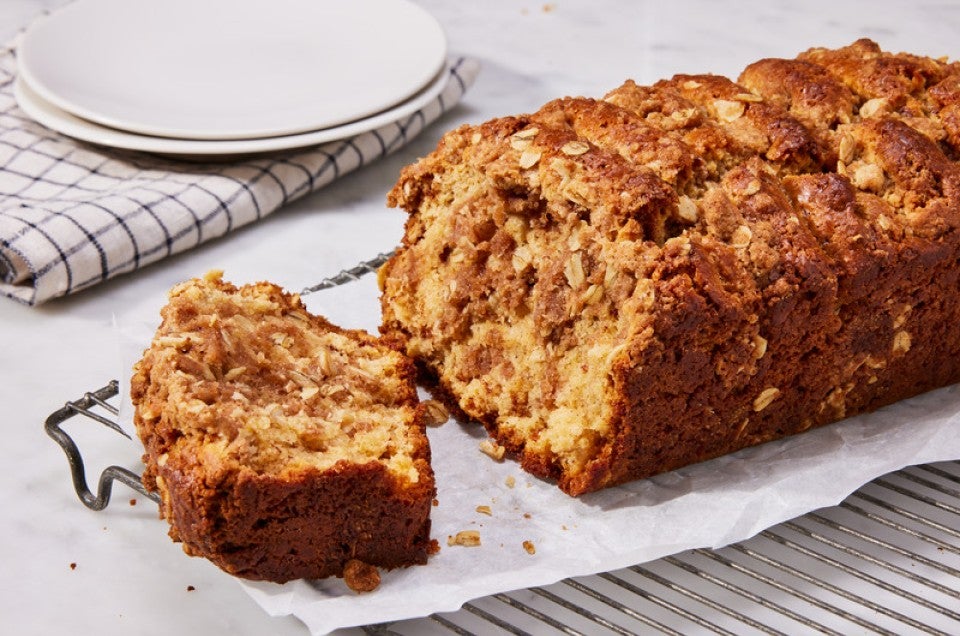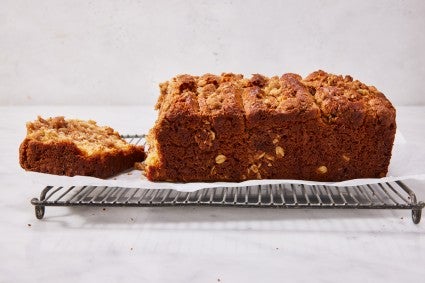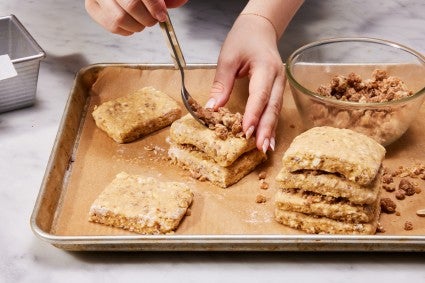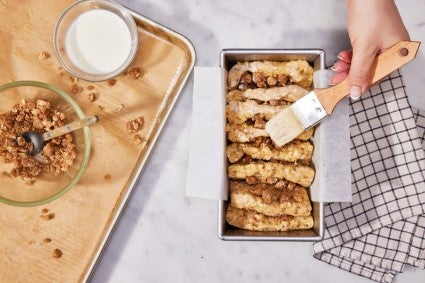How to turn scone mix into an irresistible scone loaf
Loaf cake meets scones, lives happily ever after.


Scones are one of my all-time favorite baked goods, but I’m often shy to admit it. Even the best scones — light, tender, and full of flavorful additions — can look simple and boring when compared to showier items like cinnamon rolls, Danishes, and croissants. And, while it pains me to admit it, sometimes they do taste as plain and mouth-drying as they look.
The way I convert people who think scones are just so-so? A scone loaf, which is essentially scone dough cut into squares, layered with streusel, and baked in a loaf pan. Whereas a tray of fabulous scones might make guests consider passing over a box of doughnuts, a stunning scone loaf receives audible gasps. It’s fun! It’s decadent! It has the added bonuses of a larger proportion of fluffy interior and an extended shelf life. Drizzle it with a confectioners’ sugar glaze and cut it into slices, or set it on a cutting board at the center of the table to be torn apart like monkey bread.
I first learned about scone loaves from Liz Larkin, who is famous for the scones she sells in Pound Ridge, New York, and who shared a recipe for her scone bread on Food52. But as amazing as it is, her scone loaf takes some time. So I started playing around with King Arthur’s scone mixes, beloved for producing tall, light scones in a lot less time. I found that, with the help of a mix, putting together a scone loaf is so easy that I really can do it before breakfast. Simply stir together the mix and some streusel, layer them together in a loaf pan, and bake.
Here’s how to do it in more detail:

Prepare the scone dough: First, prepare the scone mix as directed, pausing before you start to scoop or shape. My favorite mix is our French Toast Scone Mix, but choose any flavor you’d like. This will work with either a cream-based or butter-based scone mix or recipe, but I prefer a butter-based scone, which also uses eggs and milk, as these are sturdier, higher-rising, and better able to support the streusel.
Shape the scone dough: On a lightly floured surface or sheet of parchment, pat your dough into a rectangle about 1/2" thick (somewhere around 5" x 8" or 6"x 10", depending on the mix/recipe). Use a sharp knife or bench knife to divide it into 8 equal rectangles. Transfer the dough to the refrigerator or freezer while you preheat the oven to 375°F and prepare an 8 1/2" x 4 1/2" loaf pan by lightly greasing it and lining with a parchment sling.
Make your streusel crumbs: Combine 1/2 cup (60g) all-purpose flour, 1/4 cup (53g) light or dark brown sugar, 1/4 cup (23g) rolled oats, 1 teaspoon cinnamon, 1/2 teaspoon vanilla, and a pinch salt in a small bowl. Stir in 4 tablespoons melted butter to make a soft, cohesive mixture. If you’re using a cream-based scone mix, you can use cream in place of melted butter; the texture of the crumble will be softer and less crisp.
The streusel is a good place to customize your loaf: Throw in additions like cardamom, ginger, finely chopped nuts, or mini chocolate chips, or choose a recipe that plays nicely with your scone mix. For example:
And if you make a big batch of the streusel and stash it in your freezer, the next scone loaf will be even easier.

Assemble the loaf: Crumble about 1 tablespoon of filling onto one of the scone pieces, then stack another piece on top. Repeat until you have stacked four pieces. Helpful hint: If your streusel threatens to fall off the pieces of dough, brush them lightly with milk or cream so they adhere.
Carefully place the four stacked pieces in the loaf pan so that the one bare side is facing the end of the pan. Repeat with the four remaining pieces of scone dough and the remaining filling, then place the second stack in the pan next to the first stack. The loaf should be bookended with two bare scones; in the rest of the pan, there should be a layer of filling between each piece of scone. Brush the scone loaf with milk or cream. Scatter any remaining crumbs over top.

Bake the scone loaf: Bake for 45 to 50 minutes, covering with foil for the last 10 minutes if the loaf gets too dark, until golden brown all over and the internal temperature reaches 205°F.
Let cool briefly in the pan before using the parchment sling to transfer to a wire rack. Serve warm or at room temperature. All that’s left to do is watch the crowd go wild and immediately order a couple more boxes of scone mix. You'll need them!
If you're looking for a stunning from-scratch scone, try these Layered Fig and Rosemary Cornmeal Scones.
Cover photo by Rick Holbrook; food styling by Kaitlyn Wayne.

